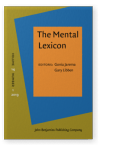Vol. 14:1 (2019) ► pp.124–151
It’s hard to be talented
What possessional adjectives tell us about lexical representation
In a visual lexical decision task, recognition is shown in two experiments to be harder for possessional adjectives that look like they are inflected verbs (e.g., talented) than for genuine inflected verbs (e.g., consulted), especially when the nonword distractors have real-word stems (e.g., infanted). Such a result implies that inflected words do not have a form-based whole word representation, but are recognized when functional information associated with their stem and affix is recombined after decomposition. A third experiment goes on to demonstrate that the addition of the verb suffix -ing to the noun stem of such pseudo-verb-stem words (i.e., talenting) leads to more erroneous classifications as a real word than when the stem is another type of noun (e.g., infanting). Moreover, a negative correlation is observed between the accuracy of recognition of the pseudo-verb-stem words and the classification as a nonword of the -ing version of their stems. On the basis of these experiments, a model is proposed in which a pseudo-verb-stem word is recognized through a lexical representation of its stem that corresponds to a bound ornative verb and which is different to the representation used to recognize its free-standing noun version.
Article outline
- Experiment 1
- Method
- Materials
- Procedure
- Participants
- Results
- Discussion
- Experiment 2
- Method
- Materials
- Procedure
- Participants
- Results
- Discussion
- Experiment 3
- Method
- Materials
- Procedure
- Participants
- Results
- Discussion
- General discussion
- Concluding remarks
- Notes
-
References
